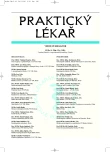Successful treatment of acute liver failure by means of artificial liver support device „Prometheus“ with following liver transplantation.
Úspěšná léčba akutního selhání jater pomocí přístrojové podpůrné terapie s následnou transplantací jater
Akutní (fulminantní) selhání jater je definováno jako náhlý nástup ikteru, koagulopatie a encefalopatie u jedinců bez předchozích známek jaterního onemocnění. Onemocnění je vzhledem k vysoké schopnosti regenerace jater do jisté míry potenciálně reverzibilní, část pacientů však nemá šanci na přežití bez včas provedené transplantace jater. Přes veškeré pokroky intenzivní medicíny je onemocnění stále zatíženo vysokou mortalitou. Komplexní terapie akutního selhání jater představuje terapii nitrolební hypertenze, stabilizaci hemodynamiky, zajištění uspokojivé ventilace a oxygenace, péči o nutriční a metabolickou rovnováhu, cílenou léčbu infekčních komplikací. Zcela zásadní význam pro přežití pacienta má časový faktor. Onemocnění je třeba včas rozpoznat, zahájit léčbu a kontaktovat specializované pracoviště s možností provedení transplantace jater. Při rozvoji encefalopatie je převoz pacienta spojen s vysokým rizikem, proto je pacienta nutno transponovat spíše dříve, optimálně ve stadiu encefalopatie I-II. Čas, po který je možno pacienta udržet ve stavu, kdy je schopen podstoupit transplantaci jater, lze prodloužit použitím přístrojové podpory selhávajících jater, která zatím není standardní součástí terapeutického protokolu. V červenci 2005 byl poprvé v České republice u pacienta s akutním selháním jater použit přístroj „Prométheus", fungující na principu frakcionované plazmatické separace a adsorbce.
Klíčová slova:
akutní selhání jater, Buddův-Chiariho syndrom, podpůrná přístrojová terapie jaterního selhání, „Prométheus", transplantace jater
Authors:
E. Kieslichová 1
; M. Ročeň 1; P. Trunečka 2; L. Janoušek 3; J. Šperl 2
; J. Petrášek 2; Š. Vítko 4
Authors‘ workplace:
Klinika anesteziologie, resuscitace a intenzivní péče, Transplantcentrum, IKEM, Praha, přednosta MUDr. E. Kieslichová
1; Klinika hepatogastroenterologie, Transplantcentrum, IKEM, Praha, přednosta doc. MUDr. J. Špičák, CSc.
2; Klinika transplantační chirurgie, Transplantcentrum, IKEM, Praha, přednosta doc. MUDr. M. Adamec, CSc.
3; Transplantcentrum IKEM, Praha, přednosta MUDr. Š. Vítko, CSc.
4
Published in:
Prakt. Lék. 2006; 86(5): 275-277
Category:
Case Report
Overview
Acute (fulminant) liver failure is defined as a sudden onset of icterus, severe coagulopathy and encephalopathy in a patient without previous symptoms of liver disease. The condition is potentially reversible due to the high regenerative capacity of the liver; however a significant proportion of patients has no chance of survival without prompt liver transplantation. Despite of all the advances in medicine, liver failure is still associated with high mortality. The complex treatment of acute liver failure consists of therapy of intracranial hypertension, stabilisation of circulation, ensuring appropriate ventilation and oxygenation, nutritional support and maintenance of metabolic homeostasis, specific treatment of infections. Time is the most important factor for survival. It is necessary to recognize the disease early, start the treatment and contact a liver centre that performs liver transplantation. As the transport of a patient with hepatic encephalopathy is associated with a high risk, it is necessary to refer the patient early, preferably in stage I or II of hepatic encephalopathy. Artificial liver support, although not yet a standard part of the treatment protocol, may prolong the period when the patient’s condition is still suitable for liver transplantation. In July 2005, the “Prometheus” device, which works on the principle of fractionated plasma separation and adsorption, was used for the first time in a patient with acute liver failure in the Czech Republic.
Key words:
acute liver failure, Budd-Chiari syndrome, artificial liver support, „Prometheus“, liver transplant.
Labels
General practitioner for children and adolescents General practitioner for adultsArticle was published in
General Practitioner

2006 Issue 5
- Advances in the Treatment of Myasthenia Gravis on the Horizon
- What Effect Can Be Expected from Limosilactobacillus reuteri in Mucositis and Peri-Implantitis?
- Metamizole in perioperative treatment in children under 14 years – results of a questionnaire survey from practice
- Memantine Eases Daily Life for Patients and Caregivers
- Metamizole vs. Tramadol in Postoperative Analgesia
Most read in this issue
- Temporal arteritis and polymyalgia rheumatica – an acute condition in rheumatology.
- Congenital syphilis again on the scene worldwide. II. Clinical picture.
- Negative pressure wound therapy at patients with diabetic foot. (Vacuum Assisted Closure)
- Effect of piracetam on severe vascular type dementia symptoms – nonintervention retrospective follow-up
